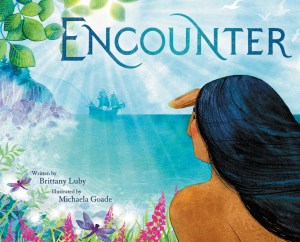We Are Still Here: Thoughts on Indigenous Representation

For Indigenous people in our country, accurate and respectful representation is a rarity.
I am very grateful to be involved in a community of Indigenous creators and educators who are helping to shift this narrative. While we may be working with different publishers, we are all sharing our unique stories and in doing so, helping build a different future for all of our children. I have had the great honor to illustrate books written by Indigenous authors from the Tlingit, Anishinaabe, Ojibwe, Nehiyaw and Upper Skagit nations. I am so grateful for these creators and the stories they’ve shared. They represent a diverse range of backgrounds and experiences that together, make up an inspiring tapestry of contemporary Native American identity.
Indigenous peoples are not stereotypes relegated to the past. We are not the “vanishing Indian” or any romanticized caricature attempting to recapture a nostalgia that never was. We are not the vilified “warrior,” the “noble savage,” or the “Indian Princess.” We see and hear other damaging stereotypes, but what we don’t often hear is discussion of colonialism and its systematic and relentless attempts to eliminate every remnant of Indigenous existence. There’s no talk of the trauma that continues to pass down from one generation to the next. Often times, there is no mention of Indigenous peoples at all. Children’s books are reflections of our society – they communicate to our children who is important and visible in our world. What message are we sending our children when whole nations of people are excluded?
Indigenous peoples are not gone. We are still here. We belong to ancient and distinct nations that have been shaped by legacies of resistance and resilience. We belong to nations built on sacred stories, histories, relationships with the land and with each other, all reflecting powerful perspectives that hold the power to change the world.
It’s my hope that our work encourages Native children to feel pride in who they are. I want them to see their diverse experiences reflected back to them. I want them to know that their culture is respected and important in a world that too often tells them the opposite. For non-Native children, it’s vital that they grow up seeing accurate Indigenous representation – repeatedly – so that they understand Indigenous Nations are still here. For when we foster cross-cultural awareness and respect, we reinforce positive attitudes towards diversity and identity. When we all work towards this common goal, we gain an awareness, acknowledgement and consideration for the original stewards of this country who have endured and lost so much. We gain empathy and compassion. We help instill these values in our children, and they themselves become better stewards of this world.
It is certainly a brighter time in children’s publishing today. This season alone we celebrate a beautiful array of books telling Native stories by Native people. I’m happy to see Encounter, written by Brittany Luby, out this year. As the illustrator, I was intrigued by the idea of positive encounters, shifting perspectives and the difficult questions we are encouraged to explore. While Encounter reimagines a day in history and asks what might have been, other books this season delve into the way history unfolded. It is with gratitude that I share a few recommendations here. Fry Bread by Kevin Noble Maillard (Seminole), illustrated by Juana Martinez-Neal; At the Mountain’s Base by Traci Sorell (Cherokee), illustrated by Weshoyot Alvitre (Tongva); Indian No More by Charlene Willing McManis (Grand Ronde) with Traci Sorell; Apple in the Middle by Dawn Quigley (Turtle Mountain Ojibwe); and I Can Make this Promise by Christine Day (Upper Skagit) are just a few recent additions to a growing canon of Native voices.
There are hundreds of Indigenous nations in our country, each with their own unique culture, history and language. This month and every month, I encourage you to seek out as many Indigenous authors as possible. Buy their books and ask your local libraries and booksellers to carry them. Read their stories with the children in your life, ask questions, encourage curiosity and don’t shy away from conversations that may seem difficult. If you don’t already know, learn the name of the nation whose traditional territory you call home. Visit their nation’s website, learn their origin story and familiarize yourself with a few words of their language. Share that knowledge. These are small steps in the right direction, but together we can help chart a more inclusive future. Together we can nurture multi-faceted representations of Indigenous peoples that truly speak to their authentic experiences for generations to come. Gunalchéesh. Thank you.
Based on the real journal kept by French explorer Jacques Cartier in 1534, Encounter imagines a first meeting between a French sailor and a Stadaconan fisher. As they navigate their differences, the wise animals around them note their similarities, illuminating common ground.
This extraordinary imagining by Brittany Luby, Professor of Indigenous History, is paired with stunning art by Michaela Goade, winner of 2018 American Indian Youth Literature Best Picture Book Award. Encounter is a luminous telling from two Indigenous creators that invites readers to reckon with the past, and to welcome, together, a future that is yet unchartered.
